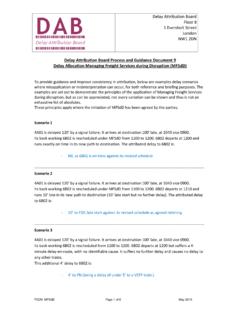Transcription of Delay Attribution Board Process and Guidance …
1 Delay Attribution Board Floor 8 1 Eversholt Street London NW1 2DN Delay Attribution Board Process and Guidance Document 3 Y Code Application This Process and Guidance Document covers the appropriate application of Y Codes and should be read in conjunction with PGD2 Reactionary Delay Principles and Examples. Notes: Understanding the Attribution of reactionary Delay is critical for performance improvement purposes, particularly DPI analysis Delays outside the Guidance of the regulation policy or where excessive lateness is involved may be considered a new prime cause The use of the word Signaller should be considered as representing ARS/TRC etc The use of the word Unit should be considered to represent all forms of rolling stock The use of line blockage , can represent any incident that prevents that passage of trains Unit failure, flood, Cable theft etc. Summary of codes.
2 CODE CAUSE ABBREVIATION YA Lost path - regulated for train running less late REG-ONTIME YB Lost path - regulated for another later running train REG-LATE YC Lost path - following train running less late FOL-ONTIME YD Lost path - following another later running train FOL-LATE YE Waiting to/from single line TO S/LINE YG Regulated in accordance with Regulation Policy REG INSTRC YI Late arrival of booked inward stock INWD STOCK YJ Late arrival of booked train-crew INWD CREW YL Waiting passenger connections within connections policy, contingency plan or otherwise agreed by NR/TOC AUTHSD CON YM Special stop orders within the contingency plan or agreed by NR/TOC AUTHSD SSO YN Service Recovery- booked train crew, not available FIND CREW YO Waiting platform/station congestion/platform alteration PLATFORM YP Delays due to diversions from booked route or line DIVERSION YQ Passenger overcrowding caused by a train being of short-formation SHRT FRMD YR Tactical cancellation for service recovery not caused by late running SR CNCL YU Service Recovery- booked rolling stock, not available UNIT SWAPS YT Reactionary Delay to a train that is not leaving the network, by a train that is leaving the network NON NR INF YX Passenger overcrowding caused by Delay or cancellation of another train or its own late running OVER CRWD DESCRIPTIONS AND EXAMPLES YA Lost path - regulated for train running less late REG-ONTIME Train A is regulated because of its own lateness, for Train B.
3 The signaller has had to make a decision of preference between the two services and has done so to the less late train. The Delay should be attributed to the largest causal incident on Train A. Example: 1A23 is running 10 late and 2B10 is 2 late, both are going to arrive at a converging junction at the same time, the Signaller gives preference to Train 2B10 as it is less late. 2B10 1A23 YA 2B10, allocated to the largest causal incident on 1A23 ---------------------------------------- ---------------------------------------- ----------------------------------- YB Lost path regulated for another later running train REG-LATE Train A is the later train and is given preference over Train B. The signaller has had to make a decision of preference between the two services and has done so to the more late train. The Delay should be attributed to the largest causal incident on Train A.
4 Example: 1A23 is running 10 late and 2B10 is 2 late, both are going to arrive at a converging junction at the same time, the Signaller gives preference to 1A23 as it is an Express. 2B10 2B10 YB 1A23, allocated to the largest causal incident on 1A23 ---------------------------------------- ---------------------------------------- ----------------------------------- PGD3: Y Code Application Page 2 of 12 June 2017 Double Regulation Scenarios and Y Code Application 2C50 is held for 1A23 and then further held for 2B10 (Taking that the regulation is in line with the regulation policy for that location) Various lateness combinations to demonstrate appropriate Y Code application:- 1A23 2B10 2C50 2C50 Delay - Y CODE Attribution 10 late 5 late RT Allocated as YB 1A23 and YB 2B10 10 late RT 5 late Allocated as YB 1A23 and YA 2B10 5 late 10 late RT Allocated as YB 1A23 and YB 2B10 RT 10 late 5 late Allocated as YA 1A23 and YB 2B10 RT 5 late 10 late Allocated as YA 1A23 and YA 2B10 In all cases the Y Codes for each regulation are allocated under normal reactionary Delay rules to the largest causal incident on the latest train at that point.
5 To ascertain the Delay allocation for the two separate regulations each must be reviewed as a regulation event in their own right. The regulation Delay due to 1A23 should be considered as taking the time 2C50 was booked across the junction to the time it would have crossed the junction once 1A23 had cleared. This is the time 1A23 passed the junction plus the junction margin. The Delay due to regulation with 2B10 would be the remainder of the Delay incurred by 2C50. Example 2C50 is delayed by 9 minutes regulated for 1A23 and then for 2B10 2C50 is booked over the junction at 15:00 1A23 passes at 15:03 2B10 passes at 15:06 2C50 finally passes at 15:09 Junction Margin is 2 minutes So Delay to 2C50 due to regulation with 1A23 = 5 minutes (It could have gone over the junction at 15:05 if not regulated again for 2B10) The remainder of Delay (9 mins total Delay less the 5 mins allocated to 1A23) is the Delay due to regulation with 2B10 Therefore a Delay of 4 minutes is due to 2B10 In the right hand diagram if 1A23 and 2B10 go across the junction at exactly the same time then 2C50 should be considered interacting with 1A23 only as being the train immediately in front.
6 2B10 going across (or not) potentially makes no difference to the Delay incurred by 2C50. 2B101A232C502B10 PGD3: Y Code Application Page 3 of 12 June 2017 YC Lost path - following train running - less late FOL-ONTIME Train A is following Train B because Train A is later and has lost its path. In the Delay section the Signaller can make no decision. The Delay should be attributed to the largest causal incident on Train A. Example: 1A23 is running 10 late and 2B10 is 2 late. 1A23 is an Express and catches up to 2B10 (which it should be in front of) on a two track section and follows it until the next junction. The infrastructure precludes any Signaller intervention 2B101A23 1A23 YC 2B10, allocated to the largest causal incident on 1A23 ---------------------------------------- ---------------------------------------- ----------------------------------- YD Lost path - following another later running train FOL-LATE Train A is following Train B because Train B is late and has lost its path.
7 In the Delay section the Signaller can make no decision. The Delay should be attributed to the largest causal incident on Train B. Example: 1A23 is running 2 late and 2B10 is 10 late. 1A23 is an Express and catches up to 2B10 (running in booked order) on a two track section and follows it until the next junction. The infrastructure precludes any Signaller intervention 2B101A23 1A23 code YD - 2B10, allocated to the largest causal incident on 2B10 ---------------------------------------- ---------------------------------------- ----------------------------------- PGD3: Y Code Application Page 4 of 12 June 2017 YE Waiting to/from single line TO S/LINE Train A is waiting for Train B to clear a single line section of track. The Delay should be attributed to the largest causal incident on the later train at the point of conflict. NOTE: This code should not be used where one train follows another train along a single line (which should be YC / YD).
8 Example 1: 1A23 is running 10 late towards Penistone and 2B10 is 2 late running from Penistone. 1A23 is booked over the single line prior to 2B10; 1A23 must now wait at Barnsley for 2B10. 1A232B10 1A23 YE 2B10, allocated to the largest causal incident on 1A23 Example 2: 1A23 is running 2 late towards Penistone and 2B10 is 10 late running from Penistone. 1A23 is booked over the single line after 2B10; 1A23 must now wait at Barnsley for 2B10. 1A232B10 1A23 YE 2B10, allocated to the largest causal incident on 2B10 ---------------------------------------- ---------------------------------------- ----------------------------------- YG Regulated in accordance with regulation policy REG INSTRUC Train A is running late, regulation policy /Train running Controller instruction specifies that Train A must be given priority over Train B. The Delay is coded to the largest causal incident on Train A.
9 Example: 1A23 is running 20 late through Peterborough, 2B10 is held 10 minutes at Peterborough in line with the agreed regulation policy. 2B101A23 2B10 YG 1A23, allocated to the largest causal incident on 1A23 ---------------------------------------- ---------------------------------------- ----------------------------------- PGD3: Y Code Application Page 5 of 12 June 2017 YI Late arrival of booked inward stock INWD STOCK Train A arrives into its terminating location late, Train B, its next schedule working departs late due to the Unit not being available at its scheduled departure time. NOTE: This code is also applicable where Unit s on a service are booked to divide on route This code is applicable when both Unit and Crew are on the same inward and outward services. The inward and outward services must be operated by the same Operator- DAPR The late start must not exceed the lateness on arrival of the inward working, with any further regulation or new prime cause incidents attributed accordingly DAPR Example 1: 1A23 is running 20 late into Euston; its next working 1A24 departs 25 minutes, 20 minutes due to its late inward and 5 minutes due to being regulated for on time 1B26 1A24 YI 1A23 (20 mins), 1A24 YA 1B26 (5 mins), allocated to the largest causal incident on 1A23 Example 2: 1C23 is formed of two units, at Birmingham the front unit continues to Manchester and the rear unit forms 1H23, a service to Holyhead.
10 1C23 arrives into Birmingham 10 late, divides off the rear unit to form 1H23 which leaves 10 late. 1C23 departs 14 late, the cause of the additional 4 minutes has no known reason so is coded to the operator of the train concerned to explain. 1H23 YI 1A23 (10), allocated to the largest causal incident on 1A23 Note: YI should not be used where the inward and outward services are operated by different companies (even if they share stock resources) ---------------------------------------- ---------------------------------------- ----------------------------------- YJ Late arrival of booked train-crew INWD CREW Train A arrives into a location of crew relief late, Train B, its next working departs late due to a crew member not being available for their scheduled departure time. NOTE: The inward and outward services must be operated by the same Operator- DAPR J1. 2 The late start must not exceed the lateness on arrival of the inward working, with any further regulation or new prime cause incidents attributed accordingly DAPR Is applicable if a train departs late due to train crew taking their delayed PNB (Including appropriate allowances such as walking time and cab preparation) DAPR Example: 1A23 arrives 20 late into Euston; 1A24 departs 20 minutes late awaiting the Driver from 1A23, after the Driver has their PNB.




